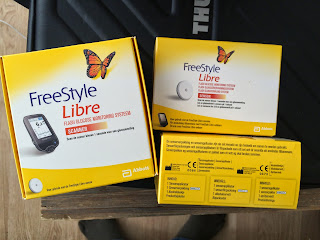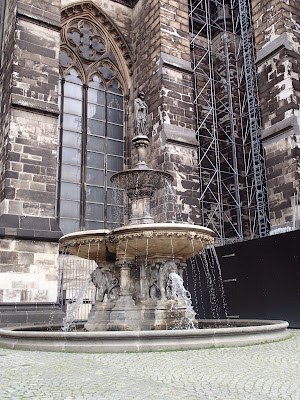Last week I was the happy recipient of one of the new "flash" glucose sensors manufactured by Abbott. Having read some of the reviews for it (an especially good one can be found here), and after my prior experiences with the Medtronic Enlite sensor, I was looking forward to trying out something more low-profile and "dumb."
A bit of background before I get going:
As you have probably figured out by now, I live a pretty active life. Running, hiking, climbing, etc. are a big part of my life. In order to do this, I have developed very good control over the past 20-something years (my A1C's have been between 5.9 and 6.2 for quite a while). In other words, I'm not the target demographic for continuous glucose monitors (CGMs) or sensors, which are generally marketed to people with poor control or who are trying to become (or are currently) pregnant. My motivation for a sensor is simple: I want to be able to track my blood sugars when I'm exercising in order to improve my performance and push my limits. It's difficult to do this using only finger sticks, since you don't get trends.
So shortly after Medtronic released their Enlite sensor in the US, I got my hands on one. Unfortunately, while it has some very nice features like the threshold suspend and continuous glucose feedback, it proved to be extremely pressure sensitive and the adhesive wasn't up to par for my regularly sweaty skin. The pressure sensitivity proved to be a deal breaker. The Enlite is approved for use on the abdomen, which means it is prone to pressure from pants, underpants, bending, waist belts, etc. This wouldn't be a big deal, except when exposed to external pressure the sensor loses its calibration and gives false readings. Then you get alarms, have to re-calibrate it, and, often in my case, the sensor only lasts a couple of days rather than the 7 it's supposed to.
In short, the Enlite CGM isn't designed with athletes in mind. Which is fine, but it means that I stopped using it because it was getting very, very annoying.
The Flash sensor is different from the available CGM's because it's, well, not a CGM. You get a hand-held reader that you scan the sensor with to get a "flash" reading. So basically, it's a substitute for finger sticks and doesn't constantly transmit data to an insulin pump or reader that can alert you to low or high blood sugar levels and cause alarm fatigue.
The sensor starter kit arrived in a surprisingly small box containing the reader and two sensors, approved for 14 days each.
The reader is smaller than an iPhone 4s and weighs nothing, which is always a good thing. It has one button and a touch screen. Pretty idiot proof.
Because I live in the Netherlands, I got the Dutch edition of the sensor. I attempted to change the language, but I get Dutch, Norwegian, and what appears to be some variety of Slovik (don't even ask, I don't know). Luckily the instruction manual had lots of pretty pretty pictures for those of us who can't read Dutch, and once again Abbott wins major points for an idiot-proof product.
The sensors come in boxes containing everything you need to insert it, up to and including an alcohol swab. Assembly is easy: the grey thing contains the external transmitter bit, and the single-serving coffee creamer thing has the needle and actual sensor. You unscrew the clear lid, peel back the plastic cover, and push the sensor into the adhesive.
Abbott claims insertion is painless. I'm kind of a wuss when it comes to big needles (and regularly have problems when inserting my insulin pump sets as they end up in muscle. Insulin delivery into muscle burns, by the way). Medtronic claims the Enlite insertion is mostly painless, but my personal experience disagrees with that. From what I've heard from Dexcom 4 users, there is some discomfort with insertion with that, too. So I was pleasantly surprised when the sensor inserted and I didn't feel a thing.
Chalk one up for Abbott.
The transmitter is bigger than I thought it was. The reviews pretty uniformly said it was about the size of a 2 euro piece. As you can see below, it's a bit bigger than advertised, but still the lowest profile I've seen on a sensor.
The other big difference between the Flash sensor and the other sensors currently available is that it doesn't require any user calibration. Theoretically, after the initial 60 minute period (where I assume it does it's thing as far as calibration, etc) it's good to go.
Because the Flash sensor is only available in Europe, the units are mmol/L, rather than the mg/dL I've been using for the past 20 years. The conversion is fairly easy (multiply the mmol/L by 18 to get to mg/dL), but I've obviously got some adjustment that needs to happen. While the sensor appears to be pretty close to my finger stick readings (generally within 15%), I'm not taking corrections off it yet, simply because I need to become more comfortable with the units and develop more confidence in the sensor before taking insulin. This is not a criticism of the sensor, since it seems to be quite consistent and indicates trends (always a plus), but rather my well-developed sense of paranoia. I suspect over the next week or so I'll develop more trust in it.
Besides accuracy, the most important feature of sensors (in my mind) is the adhesive. In the past, I've resorted to super-gluing them on in order to get more than 2 days worth of readings. Furthermore, I tend to develop a rash from the adhesives, sweat them off (lame), or (unfortunately regularly) rip them off on stuff. The Enlite was better than some of the sensors I've used for doctor visits (not the insta-feedback ones, but the ones you put on and then download a week later so your doctor can look at them) as far as resisting a bit of pull when caught on stuff, but the adhesive could not handle sweat. Once again, the Flash sensor has impressed. Probably because of its lower profile, it is less prone to catching on things and when it does, seems to stay attached. In fact, the resilience of the adhesive is more in line with my insulin pump infusion sets, which can take a lot of abuse. Over four days I put the adhesive to the test during several runs, the usual (aka huge) amount of biking, and climbing.
Unfortunately, the adhesive wasn't strong enough to resist a rope raking across it when I took a pretty impressive fall at the top of an overhanging route and slammed into the rope. The sensor flew off, barely missed Ev, bounced over a railing to the landing, bounced over that railing, and hit the ground right next to an unsuspecting belayer. Amazingly, I didn't realize I'd lost the sensor until I finished the route and was being lowered, an impressive feat given the unsurprising amount of damage traumatically removing needles can do.
This did, however, provide an opportunity to check out the size of the sensor itself. Once again, I'm impressed with how small it is (and how painlessly it goes in and comes out).
All in all, even after being traumatically removed after 4 days, the Flash sensor managed to be the longest I've ever had a sensor stay in and calibrated. I suspect it had at least 5 more days of solid adhesive before starting to peel up around the edges (based on my experience with infusion sets and various other things that are supposed to stay in for a long time and never do).
I should note that, like all CGM's and sensors, the Flash sensor has a lag between the reported reading and actual blood sugar. This means that it is a useful tool for indicating upwards or downwards trends, but shouldn't be relied upon when you're low. If you're dropping fast check your blood so you can correct. I know I'm beating a dead horse (this is glucose sensor 101), but because the Flash sensor is more of a meter replacement, it can be easy to treat it with the same level of trust as your actual meter. Additionally, I strongly suggest doing a finger stick or two a day to make sure it's holding its calibration.
As of right now, the only downside to the Flash sensor (as far as I'm concerned) is the price. Each sensor costs 60 euros and (theoretically) lasts for 14 days, assuming it holds its calibration. While advocacy groups in the EU are working to get it covered by insurance, right now it's a hefty investment. My hope is I can continue to afford them, but if I keep ripping them out I suspect I can't.
And thus concludes my (probably unexpected and a bit uninteresting for my regular readers) review of my shiny new toy. I'm pretty excited about the potential of this sensor for athletes and hopefully it will be approved by the FDA soon.
---------------------------------------------------------------------------
UPDATE
Amazingly, the sensor stayed on for the entire 14 days. The adhesive around the edges started peeling up a bit around day 9, but never got to the point where I was worried it might fall out. I did, however, notice that the calibration appeared to become a little off around day 10 (I had a couple false lows and it sometimes seemed to think I was running around 180 mg/dL when I tested at 120 (for example)).























